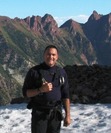Hiking Recap for 2021
If you want to set hiking goals for the new year, you should develop a reliable way to log your hikes. A fitness app and GPS device will most likely record the data for you. You should download the data for your records, so you have them for future reference. If you don’t have a smart phone, you can log your hikes in a spreadsheet. There is nothing wrong with going minimalist and not recording anything if that is best for you. I’m an engineer with a strong math and science background, so I’m an analytical type of person. I like to compare my progress from year-to-year. I’m sharing my information as an example. You should base your goals on your abilities, interests, and available time. This should be about tracking your hiking so you can see how you are doing compared to how far you want to hike. You can use your data to develop limits for easy, moderate, and difficult hiking distances.
You need to adjust your ambitions based on your fitness level, gender, and age. After an excellent year of hiking, I finished the year feeling good about my fitness level. I hiked as often as I could. I’m a male. I was 56 for five months of the year and 57 for the rest of the year. I’m not a competitive hiker or trail runner. I have a full-time traditional job. I also have peripheral neuropathy in my feet, which causes significant pain. Peripheral neuropathy is a disease that damages the sensory nerves. It causes pain, numbness, tingling, and reduced circulation. I get some relief from medicine, compression socks, and good hiking boots.
I also count walking for exercise in my hiking miles, but not walking as a normal part of the day. If I’m on a trail, I log it as hiking. If I’m on a regular sidewalk, I call it walking. I don’t do a lot of jogging, but I also count jogging around a track or elsewhere since it is time dedicated to exercise.
For comparison, I included my data for 2020, 2021, and for my lifetime (see the table below). Because of mandated travel restrictions in 2020, I didn’t have much hiking time in the mountains. So, I didn’t get much vertical gain. Most of my hiking in 2020 was in nearby open spaces. For last year, I entered a Map My Walk App challenge to hike as many miles as possible. I challenged myself to get as much vertical climbing as I could. I finished in the top 9% of people in the challenge. That was one motivating factor for last year, but not the most important one. My biggest motivator was a need to relieve stress and to decompress. I used a Garmin Instinct watch and the Map My Walk App on my phone. That allowed me to compare the accuracies of each against each other. They were within 5% of each other. I’m planning to only use my Garmin in 2022 because the Map My Walk App drains my phone battery too fast. I liked the app and used it from 2014 to 2021. But I love the Garmin Instinct. On the topic of hiking apps, the free Colorado Trail Explorer (CO Trex) application is a great map tool. It provides an accurate topographic map and is useful for navigating when hiking on or off trail. One drawback is that it is only for Colorado.

About my “lifetime” statistics, I’m still compiling the data. I did a lot of hiking, climbing, and backpacking before having the conveniences of modern technology. For several years I kept track of my hiking information by writing it in a paper notebook. I wasn’t consistent about doing that. I’ve used Excel spreadsheets for a long time, but I didn’t always record my information in there either. No matter what system you use, it takes discipline to collect the data.
Now I have good baseline or benchmark statistics to compare this year with. I found that 10 miles is at my upper limits for a hiking distance, and that 5 to 7 miles is a comfortable hiking range for me. My average hike in 2021 was 5.0 miles. I hope you have a wonderful year. Get out to enjoy outdoor recreation as often as you can. Nature, sunshine, and fresh air is good for your body and soul.
 From left to right: Mt. Meeker (13,868 ft), Longs Peak (14,259 ft), and Mt. Lady Washington (13,245 ft) in Rocky Mountain National Park (TJ Burr, 2017). Longs Peak is my favorite mountain in Colorado. __ATA.cmd.push(function() { __ATA.initDynamicSlot({ id: 'atatags-26942-626b92e8055a5', location: 120, formFactor: '001', label: { text: 'Advertisements', }, creative: { reportAd: { text: 'Report this ad', }, privacySettings: { text: 'Privacy', } } }); });
From left to right: Mt. Meeker (13,868 ft), Longs Peak (14,259 ft), and Mt. Lady Washington (13,245 ft) in Rocky Mountain National Park (TJ Burr, 2017). Longs Peak is my favorite mountain in Colorado. __ATA.cmd.push(function() { __ATA.initDynamicSlot({ id: 'atatags-26942-626b92e8055a5', location: 120, formFactor: '001', label: { text: 'Advertisements', }, creative: { reportAd: { text: 'Report this ad', }, privacySettings: { text: 'Privacy', } } }); });
TJ Burr, Rocky Mountain Adventures & Insights



